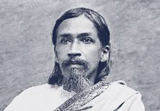Integral Health
The metaphysical basis for integral health — individual destiny
In ordinary life, the human destiny is at first to survive the battle of life and when that has been made secure, the destiny shifts to be in possession of circumstances. In contrast, the higher destiny of mankind is to seek God, have a realisation of God or even identification with God. In the fifth Chapter of The Life Divine titled ‘The Destiny of the Individual’, Sri Aurobindo traces the trajectory of the higher destiny that leads to Godhead.
However the Aurobindonian paradigm does not deal with an anthropomorphic version of Godhead. It does not merely deal with an extracosmic creator or a benevolent Ruler or an abstract ethereal concept. In fact, God is a complex construct, a Divine Consciousness that is simultaneously relevant at the Transcendental, Universal and Individual poises of the same underlying Reality. Moreover this Divine Reality contains everything and is also contained in everything besides being identified with everything. Therefore any realisation or identification with the Godhead or Divine Consciousness has to be simultaneously relevant at multiple levels, necessitating an integral movement towards an integral Reality.
A closer enquiry reveals that an integral realisation of the divine consciousness actually includes and surpasses all the conventional pathways to God that have been practised throughout history. The difference is that usually each single pathway traversed has been held to be exclusive by its voyagers. The integral approach actually rises above all exclusivism. In contemporary usage, the transcendental approach has been eulogised to such an extent that God is considered to be a Transcendental Reality. Now, if one identifies with ‘God’ or ‘Reality’ at the transcendental poise, one can get such an overwhelming experience that an identification with Reality at other poises (Cosmic and Individual) becomes unnecessary, insignificant and not worth the trouble! The integral approach however gives equal significance to all aspects and considers the transcendental, cosmic (universal) and individual poises as representing the same Reality in different denouements.
Manifesting God
In Sri Aurobindo’s scheme of things, if one has to identify with God or the divine consciousness in an integralist perspective, then identification with the Transcendence does not suffice; the identification has to take equal cognisance of the transcendental, cosmic and individual poises of the Reality. But even then Sri Aurobindo is not satisfied with a mere identification with the Reality at all levels. For him the crowning glory of the individual destiny is to manifest the Transcendence in individual, earthly terms.
Obviously, such a concept might seem blasphemous to some conventional schools of theology for whom the ‘impurity’ of the body does not permit it to be inhabited by the Divine effulgence. (In a workshop when a coordinator was pointing at her own heart to indicate that God was ‘inside’, the individual —an adolescent from a particular Semitic religion shouted and raised her fingers to show that God’s seat was above (The Transcendence) —the ensuing debate resulted in the respondent getting exasperated.) However, Sri Aurobindo appreciates this standpoint too, for in his scheme, the manifestation of the Transcendence in the individual (who is ‘impure’) cannot succeed unless a ‘transformation’ of consciousness is initiated at the individual level. Thus the ‘manifestation’ of Transcendence in earthly terms necessitates a preparation through a ‘transformation’ of consciousness at the individual level and both these movements are necessary and complementary to each other. Of course, the individual has to initiate this process by transcending the ego. Even then, Sri Aurobindo considers that an individual salvation (which starts by ego-surpassing) might bring heavenly laurels but has no merit for earthly life unless the Transcendence manifests in the individual.
However the individual does not exist in a vacuum but in the matrix of universal consciousness. Hence the conscious manifestation of the Transcendent in the individual automatically implies that the ‘Universal’ (Cosmic) too gets permeated with the transcendental consciousness. Once a single individual is illumined, other receptive individuals also get stimulated across the matrix of universal consciousness. This means that the ‘illumined individual’ (who has transcended his ‘ego’) is necessary and imperative for the world-play. It has been traditionally held that the ‘extinction’ of the individual is an epitome of individual salvation. The individual is considered to be too small and insignificant when compared with the vastness of the universe and the grandeur of the transcendence. For Sri Aurobindo, the ‘extinction’ of the ‘ego’, which is a prime requisite for God-realisation is not equated with the ‘extinction’ of the ‘individual’; the ego-transcending ‘illumined individual’ is as important as the Transcendent Reality.
Vertical, vis-à-vis horizontal expansion
In fact, the ‘illumined individual’ does not selfishly move towards salvation in a vertical manner. Rather one’s consciousness influences the gestalt too and gets replicated in susceptible individuals scattered in time and space in the matrix of the universal consciousness. “The liberation of the individual soul is… the keynote of the definite divine action… It is the point of Light at which the intended complete self-manifestation in the Many begins to emerge. But the liberated soul extends its perception of unity horizontally as well as vertically. Its unity with the transcendent One is incomplete without its unity with the cosmic Many. And that lateral unity translates itself by a multiplication… The divine soul reproduces itself in similar liberated souls… whenever even a single soul is liberated, there is a tendency to an extension… Where shall we fix the limit of that extension? Is it altogether a legend which says of the Buddha that as he stood on the threshold of Nirvana, of the Non-Being, his soul turned back and took the vow never to make the irrevocable crossing so long as there was a single being upon earth undelivered from the knot of the suffering, from the bondage of the ego (1)?”
The individual destiny is not to get obliterated in the vastness of the cosmos, not to get extinguished in the glow of the transcendence. If the ‘Transcendent’ is eternal while the ‘Cosmos’ and the ‘Individual’ are ‘relative and phenomenal’, even then, ‘Brahman’ (The Being, The Reality, the Absolute) has consented to be represented in temporal terms just to experience the joy of self-manifestation in limited terms. “Brahman is in this world to represent Itself in the values of Life. Life exists in Brahman in order to discover Brahman in itself. Therefore man’s importance in the world is that he gives to it that development of consciousness in which its transfiguration by a perfect self-discovery becomes possible. To fulfil God in life is man’s manhood. He starts from the animal vitality and its activities, but a divine existence is his objective (2).”
Thus the spiritual pathway to identification with the Transcendent is as important as the existential pathway to individual perfection. If the former encompasses sophisticated yogic and mystic techniques, the latter does not exclude an integral approach to personal growth. If the spiritual pathway to the Transcendent or to the Cosmos deals with the ethereal echelons of consciousness, the pathway to personal growth includes a holistic perspective of health too. A perfected after-life in heaven does not harbour a concern about the bodily life which may indeed be looked upon as a burden or obstruction. That is why there are some religious approaches that encourage tormenting and torturing the body. In Sri Aurobindo’s paradigm, the destiny of the individual leads to a transformation of the body by manifesting the Supreme Consciousness in terms of earthly reality. Not a body impoverished by conscious suffering but glorified for perfection in the manifestation is the cherished goal. It is imperative that a new paradigm of integral health must arise to serve this great destiny of the body awaiting its hour of glory.
References
1. Sri Aurobindo. Birth Centenary Library, Volume 18. Pondicherry: Sri Aurobindo Ashram Trust; 1970, p. 40.
2. Ibid., p. 36.
Share with us (Comments, contributions, opinions)
When reproducing this feature, please credit NAMAH, and give the byline. Please send us cuttings.




